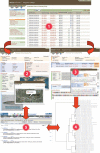Identifying Canadian freshwater fishes through DNA barcodes
- PMID: 22423312
- PMCID: PMC3278308
- DOI: 10.1371/journal.pone.0002490
Identifying Canadian freshwater fishes through DNA barcodes
Abstract
Background: DNA barcoding aims to provide an efficient method for species-level identifications using an array of species specific molecular tags derived from the 5' region of the mitochondrial cytochrome c oxidase I (COI) gene. The efficiency of the method hinges on the degree of sequence divergence among species and species-level identifications are relatively straightforward when the average genetic distance among individuals within a species does not exceed the average genetic distance between sister species. Fishes constitute a highly diverse group of vertebrates that exhibit deep phenotypic changes during development. In this context, the identification of fish species is challenging and DNA barcoding provide new perspectives in ecology and systematics of fishes. Here we examined the degree to which DNA barcoding discriminate freshwater fish species from the well-known Canadian fauna, which currently encompasses nearly 200 species, some which are of high economic value like salmons and sturgeons.
Methodology/principal findings: We bi-directionally sequenced the standard 652 bp "barcode" region of COI for 1360 individuals belonging to 190 of the 203 Canadian freshwater fish species (95%). Most species were represented by multiple individuals (7.6 on average), the majority of which were retained as voucher specimens. The average genetic distance was 27 fold higher between species than within species, as K2P distance estimates averaged 8.3% among congeners and only 0.3% among concpecifics. However, shared polymorphism between sister-species was detected in 15 species (8% of the cases). The distribution of K2P distance between individuals and species overlapped and identifications were only possible to species group using DNA barcodes in these cases. Conversely, deep hidden genetic divergence was revealed within two species, suggesting the presence of cryptic species.
Conclusions/significance: The present study evidenced that freshwater fish species can be efficiently identified through the use of DNA barcoding, especially the species complex of small-sized species, and that the present COI library can be used for subsequent applications in ecology and systematics.
Conflict of interest statement
Figures


Similar articles
-
DNA barcodes discriminate freshwater fishes from the Paraíba do Sul River Basin, São Paulo, Brazil.Mitochondrial DNA. 2011 Oct;22 Suppl 1:71-9. doi: 10.3109/19401736.2010.532213. Epub 2011 Jan 27. Mitochondrial DNA. 2011. PMID: 21271849
-
DNA barcoding to characterize biodiversity of freshwater fishes of Egypt.Mol Biol Rep. 2020 Aug;47(8):5865-5877. doi: 10.1007/s11033-020-05657-3. Epub 2020 Jul 13. Mol Biol Rep. 2020. PMID: 32661870
-
DNA barcoding Indian freshwater fishes.Mitochondrial DNA A DNA Mapp Seq Anal. 2016 Nov;27(6):4510-4517. doi: 10.3109/19401736.2015.1101540. Epub 2015 Dec 24. Mitochondrial DNA A DNA Mapp Seq Anal. 2016. PMID: 26703324
-
The campaign to DNA barcode all fishes, FISH-BOL.J Fish Biol. 2009 Feb;74(2):329-56. doi: 10.1111/j.1095-8649.2008.02080.x. J Fish Biol. 2009. PMID: 20735564 Review.
-
Five years of FISH-BOL: brief status report.Mitochondrial DNA. 2011 Oct;22 Suppl 1:3-9. doi: 10.3109/19401736.2010.535528. Epub 2011 Jan 27. Mitochondrial DNA. 2011. PMID: 21271850 Review.
Cited by
-
First DNA Barcode Reference Library for the Identification of South American Freshwater Fish from the Lower Paraná River.PLoS One. 2016 Jul 21;11(7):e0157419. doi: 10.1371/journal.pone.0157419. eCollection 2016. PLoS One. 2016. PMID: 27442116 Free PMC article.
-
Contrasting population genetic structure among freshwater-resident and anadromous lampreys: the role of demographic history, differential dispersal and anthropogenic barriers to movement.Mol Ecol. 2015 Mar;24(6):1188-204. doi: 10.1111/mec.13112. Epub 2015 Mar 6. Mol Ecol. 2015. PMID: 25689694 Free PMC article.
-
A comprehensive DNA barcoding of Indian freshwater fishes of the Indus River system, Beas.Sci Rep. 2024 Feb 2;14(1):2763. doi: 10.1038/s41598-024-52519-0. Sci Rep. 2024. PMID: 38307873 Free PMC article.
-
Establishing and using a genetic database for resolving identification of fish species in the Sea of Galilee, Israel.PLoS One. 2022 May 19;17(5):e0267021. doi: 10.1371/journal.pone.0267021. eCollection 2022. PLoS One. 2022. PMID: 35587493 Free PMC article.
-
DNA barcoding of nymphalid butterflies (Nymphalidae: Lepidoptera) from Western Ghats of India.Mol Biol Rep. 2012 Mar;39(3):2375-83. doi: 10.1007/s11033-011-0988-7. Epub 2011 Jun 14. Mol Biol Rep. 2012. PMID: 21670958
References
-
- Hebert PDN, Gregory TR. The promise of DNA barcoding for taxonomy. Systematic Biology. 2005;54:852–859. - PubMed
-
- Ratnasingham S, Hebert PDN. Molecular Ecology Notes. 2007;7:355–364. Bold: The barcode of life data system ( www.barcodinglife.org). - PMC - PubMed
-
- Ball SL, Hebert PDN, Burian SK, Webb JM. Biological identification of mayflies (Ephemeroptera) using DNA barcodes. Journal of the North American Benthological Society. 2005;24:508–524.
Publication types
MeSH terms
Substances
LinkOut - more resources
Full Text Sources

